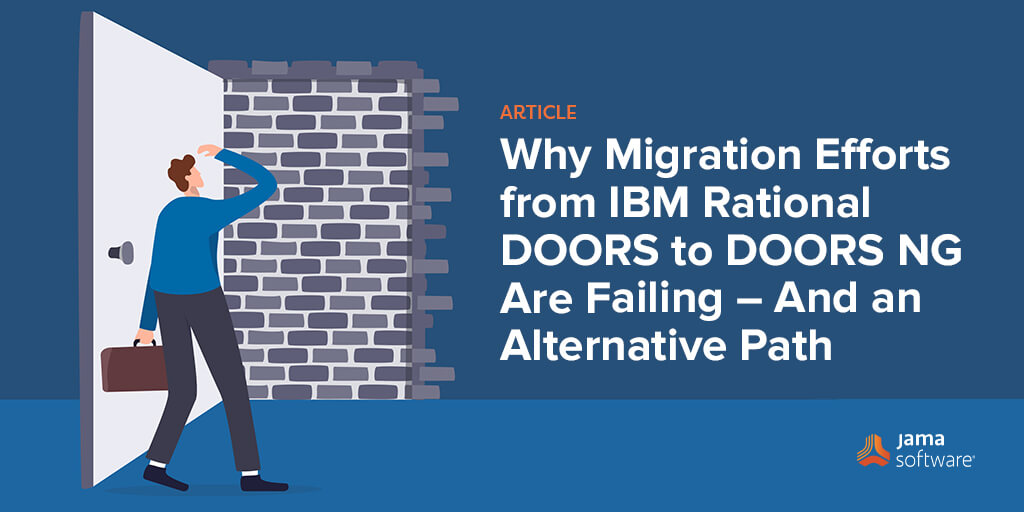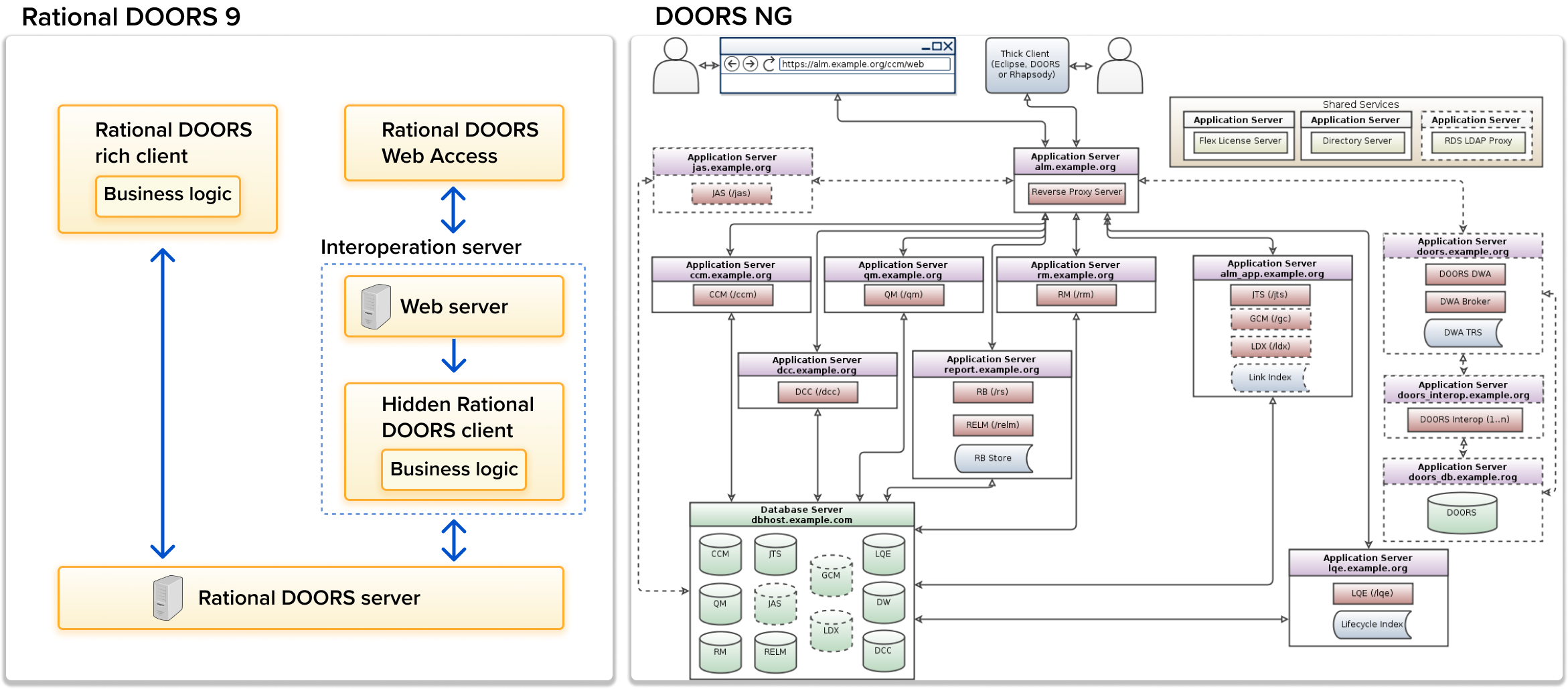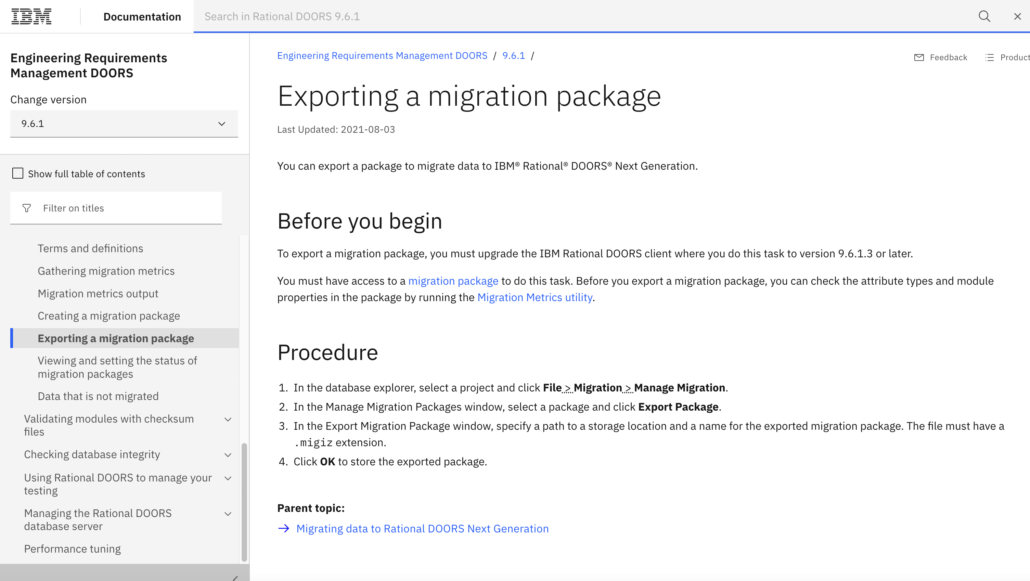
Why Migration Efforts from IBM Rational DOORS to DOORS NG Are Failing – And an Alternative Path.
IBM Rational DOORS was built in 1991 when it became clear that document-based tools such as Microsoft Office did not offer the capabilities able to manage and analyze requirements traceability. And while it was revolutionary at the time, not much has changed about the product in over 30 years.
Many teams are looking to switch away from Rational DOORS because of IT mandates, poor usability due to an antiquated user interface, lack of collaborative features, and a host of other reasons.
However, thinking that migrating to DOORS Next Generation is the easiest, most logical next step is a mistake. In this post, we’ll discuss why many migration efforts from IBM Rational DOORS to DOORS NG are failing, and provide a simpler, more modern alternative.
Considering a switch? If you want to move away from IBM Rational DOORS, you are not constrained by a specific path of migration.
Leaders might already understand the need to switch from Rational DOORS, but they aren’t sure of the next best step. Some lean toward switching to IBM DOORS NG with the assumption that it will be easier to learn and deploy than starting from scratch with a new solution.
However, the only thing that DOORS Next shares with the original DOORS is the name; otherwise, it’s a completely different platform that takes the same level of migration effort that any migration away from DOORS legacy would take. Any expensive DXL customizations — which can sometimes add up to more than a million lines of code — cannot be migrated to DOORS Next.
As you make your decision on whether to migrate away from DOORS or not, consider the risks associated with DOORS and the benefits of choosing a different option.
Risks may include:
- Loss of control and employee frustration. Employees frustrated with DOORS work outside of DOORS, most often in Microsoft Word or Excel, which means that requirements are no longer maintained in a central system and a rigorous process is not followed. This leads to an inability for management to monitor key metrics for the end-to-end process to identify process risk patterns.
- Increased operational costs. Continuing the existing path of using DOORS increases an organization’s risk and expense complying with ever demanding IT security regulations.
- Disruption in business. New users are reluctant to pick up the antiquated user interface of DOORS, expecting software to be as intuitive as applications in their social environment. Not having the ability to move fast and scale business to meet innovative market demands will cost your business time and resources.
- Missed market opportunities. Errors, defects, and omissions not found until the end of the process cause costly delays and overruns. A company’s long-term success can be hindered by delayed launches and missed market opportunities.
- Increased exposure to risk in regulated markets. A requirements management tool helps you stay compliant and increase visibility in regulated markets. Limited customer and cross-functional involvement in the review and approval of requirements and a lack of stakeholder alignment create unnecessary risks. And, the absence of process exception tracking, which determines if requirements have been omitted or modified, creates additional exposure. With more stakeholders refusing to use DOORS, compliance is checked after the fact with the arduous task of tool admins importing data and then running trace analysis. Extended stakeholders who are using DOORS are only able to see any errors long after they have been introduced and eventually imported.
- Distraction from the core business. An ineffective requirements management tool encourages organizations to create customizations rather than simply configuring a tool to meet process needs. Developing and maintaining ad-hoc customizations forces an organization to focus on how to create requirements management functions rather than focus on core business. A modern requirements management solution enables teams to work faster and more efficiently, leading to faster time to market.
Related: The Inside Story: Data-Model Diagnostics for IBM® DOORS®
Need more proof? Here’s what IBM says about migrating from IBM Rational DOORS to DOORS NG
Looking at Rational DOORS and DOORS NG Side-by-Side
It may sound like migrating from Rational DOORS and DOORS NG is just a click of a button, the two systems have completely different infrastructure, processes, and structure. It’s a very complex and manual process. In fact, migrating to DOORS NG will cause major architectural shifts that will impact performance and require extensive employee training.
Related: Requirements Traceability, Does My Data Matter?
There are a number of data types, including historical data, that can’t be migrated at all. But don’t take it from us; IBM says it themselves.
Additionally, there is no upgrade path from Rational DOORS to DOORS NG
5 Common Migration Myths Debunked
Transitioning to a new solution doesn’t have to be challenging; however, there are some assumptions that mislead us into thinking that difficulty is inevitable. Consider the following myths:
MYTH 1: Migrating away from IBM solutions will be more expensive. The amount of work that goes into upgrading to DOORS Next or transitioning to a new RM solution is the same, differentiated only by the quality of the tool and services available to help with migration. An option other than the DOORS family is most often a better fit for your organization.
MYTH 2: Customization will carry over to DOORS Next. You spent a lot of time customizing IBM DOORS and may believe those customizations will transition seamlessly to DOORS Next. However, this isn’t the case and is the reason selecting a different solution doesn’t involve more work.
MYTH 3: DOORS is already deployed and cheap to maintain. Continuing the current path with IBM DOORS is an expensive option in the long term, and often requires dedicated personnel. Switching to an alternative RM solution can improve efficiency while saving money.
MYTH 4: Business disruption is too difficult. The right RM tool will empower teams to effectively hit deadlines, collaborate, and improve business outcomes
MYTH 5: The user experience will suffer., Many people refuse to use DOORS due to a challenging user experience. DOORS Next is a completely new tool with a new user experience. Adopting a user-friendly solution allows teams to collaborate far more effectively as team members can accelerate concepts, designs, and validations for faster times to market.
Related: Moving from Modules to Models – Is it finally time to leave IBM® DOORS® behind?
Migration Away from IBM Rational DOORS is Inevitable – Here’s An Alternate, Easier Path
The fact is, IBM DOORS is extremely outdated, and at some point, updates and support will inevitably end.
If you’re currently using DOORS, you likely know that moving to a different solution is necessary, and you might be considering DOORS Next. However, fast-shifting market dynamics require a new approach to accelerate innovation. As a modern alternative to traditional legacy platforms, Jama Connect® enables digital transformation with a more efficient and user-friendly approach to managing risk and compliance.
Customers agree, naming Jama Connect the overall leader (#1) in requirements management software on G2, outranking IBM DOORS Next for implementation time, adoption, ROI, and market presence.
Jama Connect is a proven IBM DOORS alternative with flexible and reliable solutions, including:
Operation in an IBM DOORS supply chain. Innovative companies leverage Jama Connect to get up and running fast with a modern requirements management process that tightly aligns with industry standards and practices that support regulatory compliance. Organizations can connect to customers and suppliers that use IBM DOORS through Data Exchange for Jama Connect.
Integration services. Jama Connect provides integration with key product development lifecycle tools.
Coexists with IBM DOORS. IBM DOORS is embedded in many organizations and may take some time to migrate completely. Progressive teams and divisions can get started on Jama Connect quickly while the larger organization works toward replacing existing programs over time. This approach is supported through a mix of integration, migration, and exchange services.
Are you considering DOORS for requirements management or considering making a switch? Learn more in our eBooks, Why Move Away from IBM® DOORS® Legacy, and Why Now? and Moving from DOORS Next® to Jama Connect® for Requirements Management
Achieving Live Traceability™ with Jama Connect®
Jama Software®‘s Live Traceability™ allows engineering teams to quickly and easily access the latest and most complete information for any requirement, no matter the stage of development or tools used. This real-time capability boosts productivity by ensuring teams work with the latest data and reduces risks like delays and defects by finding issues early. Research shows that issues found late can be much more expensive to fix, which is why Live Traceability is so important. Jama Connect® helps overcome the limitations of older tools, leading to better results in many industries such as automotive, medical devices, aerospace & defense, and more. To learn more, visit Buyer’s Guide: Selecting a Requirements Management and Traceability Solution
To learn more about the three flexible approaches to support companies moving away from IBM DOORS and how our migration team can help, download our datasheet.
- Understanding ISO 26580: The Standard for Agile Product Line Engineering - February 25, 2025
- Jama Connect® Features in Five: Jama Connect Interchange™ – Universal ReqIF Import - December 6, 2024
- Migrating from IBM DOORS: Why and How Rockwell Automation Made the Switch - September 26, 2024



